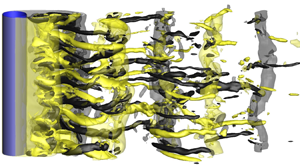Article contents
Direct numerical simulation of the turbulent kinetic energy and energy dissipation rate in a cylinder wake
Published online by Cambridge University Press: 02 August 2022
Abstract

The turbulent kinetic energy and energy dissipation rate in the wake of a circular cylinder are examined at a Reynolds number of 1000. The turbulence characteristics are quantified using direct numerical simulation, which provides a comprehensive dataset that is almost impossible to acquire from physical experiments. The energy dissipation rate is decomposed into the components due to the mean flow, the coherent primary vortices and the remainder. It is found that the remainder component, which develops only in a three-dimensional turbulent wake and resides mainly in the regions of vortices, accounts for 95 % and 97 % of the total dissipation rate for 10 and 20 cylinder diameters downstream of the cylinder, respectively (while the remainder accounts for 62 % and 83 % of the total turbulent kinetic energy). Based on the remainder component, the validity of local isotropy, local axisymmetry, local homogeneity and homogeneity in the y–z plane for the turbulent dissipation in the wake is examined. The analysis reveals that the turbulent dissipation is largely locally homogeneous, but not locally isotropic or axisymmetric, even after the annihilation of the primary vortex street. In addition, the performances of the four corresponding surrogates to the true dissipation rate are evaluated. Owing to the general validity of local homogeneity, the surrogates of local homogeneity and homogeneity in the y–z plane perform well. Although local axisymmetry does not hold, the corresponding surrogate performs well, because errors from different terms largely cancel out. However, the surrogate of local isotropy generally underestimates the true dissipation rate.
JFM classification
- Type
- JFM Papers
- Information
- Copyright
- © The Author(s), 2022. Published by Cambridge University Press
References
- 5
- Cited by





